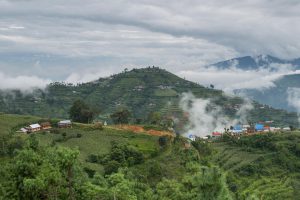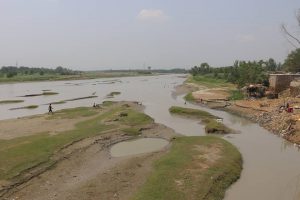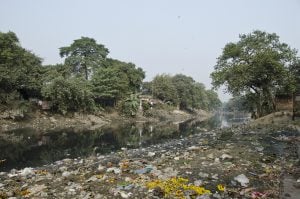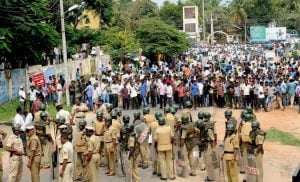The recent call by Nitish Kumar, chief minister of the Indian state of Bihar, to remove the Farakka barrage has added a new dimension to the ongoing debate on the utility of the barrage. Located in the Indian state of West Bengal, roughly 16.5 kilometres from the border with Bangladesh, the barrage was planned to enhance the flow of Bhagirathi-Hooghly branch of the Ganga to resuscitate the port at Kolkata (then Calcutta).
While the Farakka barrage has earlier been blamed for reducing water flow, causing salinity ingress and drying up of the Sundarbans delta, the problem with the management of sediments has recently taken an ugly turn with the floods in the Indian states of Uttar Pradesh and Bihar.
The government of Pakistan (which encompassed the present state of Bangladesh, created in 1971) was critical of the project. It had feared that by enhancing the flow into Bhagirathi-Hooghly, the barrage would reduce the dry season flow of the Ganga (known as the Padma in Bangladesh) downstream.
There were members of the Indian technocracy who also opposed the project, such as Kapil Bhattacharya, then chief engineer of West Bengal. He was singled out and marginalised. Since then, the construction of the barrage has been a crucial factor affecting Bangladesh-India relations and perceptions of transboundary environmental issues.
Short term solution
The Farakka barrage stands as a classic example of engineering solutions that looked at short-term economic benefits and ignored long-term sustainability concerns. This way of thinking was promoted during the British colonial period. This was the time when such large scale endeavours were being experimented with all over the world, with civil engineering being established as a discipline in the 19th century. The establishment of Thomason Engineering College at Roorkee (now the Indian Institute of Technology Roorkee) which began as a class for engineers in 1845, before being named after its founder, James Thomason, in 1854, provided young Indian students with training in the European knowledge of water engineering. This form of water management spread across engineering colleges in India over time.
This thinking dominates the Indian water engineering scenario even today, and has led to enhanced damage, livelihoods losses and eventually conflicts at both international and inter-state levels. The Farakka barrage is a classic example.
When the barrage was planned, knowledge about the complex ecology, hydrology and sediment flow of Himalayan rivers like the Ganga was either not available or ignored. So, the possible impacts of building a barrage were not perceived at the design stage.
The most significant knowledge gap in river engineering was and is related to the understanding and management of the sediments, which are integral parts of water flows. Without consideration of the sediments, the Bangladesh-India treaty of 1996 on the sharing of the dry season flows at Farakka turned out to be merely an arithmetical exercise on amounts of water to be shared, without looking at overall impact on the river systems.
See: Farakka barrage leads to water crisis in Bangladesh
See: No silver sheen in the Ganga
Floods are regular phenomena in Uttar Pradesh and Bihar. From the perspective of natural science, floods are integral components of the eco-hydrological cycle. They cause damage, but also, as the floodwater recedes, it leaves behind rich silt and sediments, which have made the Gangetic plains the “rice bowl of South Asia”. The real problems start when the floods become severe, or when they start depositing sand instead of silt.
But what happens when the silt is blocked by a barrage? The Bihar chief minister says the sediment build-up upstream of the Farakka barrage has raised the riverbed, which is worsening the flood situation. It also diverts the water meant for the Bhagirathi-Hooghly branch of the Ganga into a narrow channel in Malda district of West Bengal, leading to bank erosion and flooding.
See Photo essay: The nowhere people
Without the barrage the river would have carried the sediment to the delta and flushed some of it out to the Bay of Bengal. The Bengal delta is built on the huge sediment load carried by the Ganga and the Brahmaputra. Now the Farakka barrage seems to have incapacitated the river’s potential to perform this function. The barrage and subsequent lack of sediment separation technology seem to have punctured the “soil formation” service of the river further downstream. The avowed purpose of resuscitating the Kolkata port has not been satisfied either.
Cure worse than disease
Nevertheless, the removal of the barrage may create other problems, and might escalate the conflict between states and between nations. There is no doubt that one benefit of the barrage is amelioration of the water problem during lean seasons in the densely populated areas of West Bengal, due to the flows through the Bhagirathi-Hooghly channel. The drinking water and sanitation problems of the burgeoning Kolkata metropolis seem to have been reduced due to the Farakka barrage, which has not only resuscitated the surface water flow in the channel, but may have also ensured groundwater recharge. Removal of the barrage will negatively affect the populace and ecosystem services in this part of the state, leading to resistance, and possibly conflict.
But at the very least, the problems created by the Farakka barrage should inform new projects. There are good examples of how to build a barrage and use the sediments at the same time.
But at the very least, the problems created by the Farakka barrage should inform new projects. There are good examples of how to build a barrage and use the sediments at the same time. The Three Gorges dam on the Yangtze designed by Chinese experts helps in flood control, and also uses the peak flow to flush the sediments downstream for floodplain cultivation. However even Chinese officials admit the negative impact of this controversial project due to unintended build up of sediment behind the dam, and devastating landslides are becoming more frequent around the site.
While India needs to evolve better ecologically informed engineering, we also need to pay serious attention to the management of Himalayan rivers. Especially when discussing ideas of integrated river basin management, we need to consider river basin commissions with powers to mediate between states so as to avoid escalation of inter-state conflicts on river waters.







